


xxxxxAs we have seen, Austria’s defeat at the Battles of Magenta and Solferino, achieved by a Franco-Piedmontese military alliance in 1859, meant that most of northern Italy had come out in favour of a united Italy under Victor Emmanuel II by the beginning of 1860. In the South, the Bourbon monarchy of the Two Sicilies (Sicily and Naples) was still in power, but in April 1860 an uprising broke out in the city of Palermo, engineered by the Italian patriot Giuseppe Mazzini. To take advantage of this rebellion, the national hero and famed guerrilla fighter Giuseppe Garibaldi then took it upon himself to organise an invasion of Sicily. At the beginning of May he landed a thousand volunteers - his “Red Shirts” - on the west coast of the island and, despite the over-whelming strength of the Bourbon forces, had gained command of the island in just three months. He then crossed onto the Italian mainland and after a whirlwind campaign entered Naples in triumph in early September. Count Cavour, prime minister of Sardinia-Piedmont, alarmed that he might then attempt to liberate Rome and bring about French intervention, invaded two Papal States from the north and met up with Garibaldi in Naples, thereby welding together the north and south of the peninsula. The people of the South voted in favour of union with Sardinia-Piedmont, and in March 1861 Victor Emmanuel was proclaimed king of a united Italy. Venetia and Rome were not within this new kingdom, but, as we shall see, Venetia was incorporated at the end of the Seven Weeks’ War of 1866 (Vb), and, following the withdrawal of the French troops from Rome just prior to the Franco-Prussian War, unification was completed in 1870 (Vb).
THE STRUGGLE FOR ITALIAN
INDEPENDENCE 1860 (Va)
Acknowledgements
Map (Two Sicilies): licensed under Creative Commons. Author: Gabagool – en.wikipedia.org. Palermo: date and artist unknown. Emmanuel: by the Italian painter Tranquillo Cremona (1837-1878) – National Museum of the Italian Risorgimento, Turin, Italy. Map (Italy): licensed under Creative Commons – jsylvainwh.wikispaces.com /NATIONALISM. Garibaldi: from the American political magazine Harper’s Weekly of June 1882, artist unknown. Map (Southern Italy): detail from flanzafame.com/VivaLItaliaNotes. Meeting: detail of fresco by the Italian artist Pietro Aldi (1852-1888), 19th century – Palazzo Pubblico, Siena, Italy.
xxxxxAs we have seen, the defeat of the Austrians at the Battles of Magenta and Solferino (and several minor engagements), achieved by a Franco-Piedmontese military alliance in 1859, opened the way to a greater measure of Italian unification and independence. By the beginning of 1860 most of Lombardy had been annexed by Sardinia-Piedmont, and all of northern Italy save Venetia and a number of Papal States had declared in favour of a united Italy under Victor Emmanuel II. In the south, however, the country remained in foreign hands despite popular support for national identity.
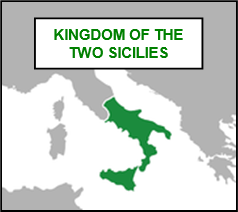 xxxxxToxrectify this situation, in April 1860 an uprising inspired by Mazzini broke out in the city of Palermo. Known as the Gancia Revolt, it aimed at overthrowing the Bourbon monarch Francis II, whose kingdom, the Two Sicilies, incorporated the island of Sicily and much of southern Italy (including the city of Naples). This was followed in May by an impromptu invasion of the island of Sicily by the Italian patriot Giuseppe Garibaldi (illustrated below). Acting entirely on his own initiative, he set sail from Genoa at the head of a small, ill-equipped army of volunteers - his one thousand “Red Shirts” - and landed at Marsala on the west coast of Sicily. After
xxxxxToxrectify this situation, in April 1860 an uprising inspired by Mazzini broke out in the city of Palermo. Known as the Gancia Revolt, it aimed at overthrowing the Bourbon monarch Francis II, whose kingdom, the Two Sicilies, incorporated the island of Sicily and much of southern Italy (including the city of Naples). This was followed in May by an impromptu invasion of the island of Sicily by the Italian patriot Giuseppe Garibaldi (illustrated below). Acting entirely on his own initiative, he set sail from Genoa at the head of a small, ill-equipped army of volunteers - his one thousand “Red Shirts” - and landed at Marsala on the west coast of Sicily. After 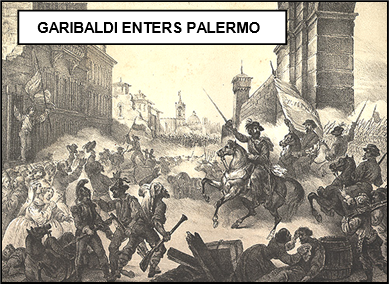 defeating a Bourbon contingent at Calatafimi, he was joined by a growing number of Sicilians. Aided by their support, the poor showing of his enemy, and his own skill and daring, he captured Palermo on June 6th and, two weeks later, won the Battle of Milazzo, thereby gaining control over all but a small part of the island.
defeating a Bourbon contingent at Calatafimi, he was joined by a growing number of Sicilians. Aided by their support, the poor showing of his enemy, and his own skill and daring, he captured Palermo on June 6th and, two weeks later, won the Battle of Milazzo, thereby gaining control over all but a small part of the island.
xxxxxAfter claiming Sicily in the name of Victor Emmanuel, and confident of further success, Garibaldi then crossed onto the Italian mainland and, with resistance virtually at an end, entered Naples as a national hero on September 7th. Francis II fled, and a final victory over the Neopolitan army at the Battle of Volturno on the first day of October completed the overthrow of the Kingdom of the Two Sicilies. Meanwhile Cavour, fearing that an impending attack on Rome by the adventurer Garibaldi might well trigger off French intervention, decided to use Piedmontese troops, led by Victor Emmanuel, to invade the papal territories of Umbria and Marche from the north, and then meet up with Garibaldi at Naples. By this diplomatic move he succeeded in welding the north and south into one kingdom. A plebiscite in the south then showed enormous support for union with Piedmont, and towards the end of October Garibaldi met up with Victor Emmanuel, greeted him as “King of Italy”, and handed over all the territory he had conquered. The unification of Italy had been achieved in large measure.
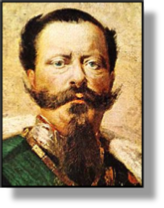
xxxxxThe Kingdom of Italy was formerly proclaimed by the first Italian parliament, meeting at Turin in March 1861, and the title of King of Italy was conferred on Victor Emmanuel (illustrated). At this time Venetia and Rome were not included in the new state (arrowed in map below). However, as we shall see, Venetia was secured at the end of Italy’s war with Austria (part of Prussia’s Seven Weeks’ War with Austria in 1866). Then, following the withdrawal of French troops from Rome, just prior to the Franco-Prussian War, the unification of Italy was completed in 1870 (Vb).
Including:
Giuseppe Garibaldi

Va-1837-1861-Va-1837-1861-Va-1837-1861-Va-1837-1861-Va-1837-1861-Va-1837-1861-Va
xxxxxThe Italian Giuseppe Garibaldi (1807-82) a charismatic leader and an outstanding guerrilla fighter, played a major part in the unification of his country. As a member of Mazzini’s Young Italy movement, he was forced into exile on a number of occasions and spent twelve years in South America, where he gained an international reputation for his skill in warfare. In Italy he took part in the 1848 revolution, fighting the Austrians in Lombardy and defending the Roman Republic against the French. He is best remembered today for his conquest of the Kingdom of the Two Sicilies in 1860. Acting independently but in the name of Victor Emmanuel, king of Sardinia-Piedmont, he landed in Sicily with just a thousand volunteers - his famous Red Shirts - and within three months had taken command of the island. He then crossed onto the mainland and, following a whirlwind campaign, entered Naples in triumph in the September. There he was joined by Piedmontese troops advancing from the north and was able to hand over his territorial gains to Victor Emmanuel in person in the October. In the 1860s he made two unsuccessful attempts to liberate Rome and fought for Italy during its war with Austria in the Seven Weeks’ War of 1866 (Vb). Known as the “hero of two worlds”, he took part in the Franco-Prussian War of 1870, fighting for the French, and then retired to his home on the island of Caprera, off the north-east coast of Sardinia. He died there in 1882.
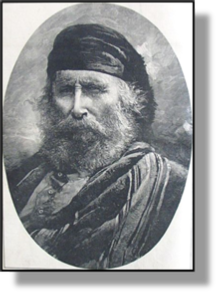 xxxxxThe Italian national hero and guerrilla fighter Giuseppe Garibaldi (1807-1882), one of the most colourful characters in military history, was born in Nice in 1807. As a young man he served in the merchant navy, but in 1833 he became a member of Giuseppe Mazzini’s Young Italy movement, involved in the struggle for unification and independence. This resulted in his being condemned to death for treason, and in 1834 he had to make good his escape. In search of adventure he became a mercenary soldier in South America, and it was there that he first displayed his fighting skill and his outstanding leadership qualities. During his twelve year stay there he gained an international reputation for the part he played in Brazil’s internal struggles and Uruguay’s war with Argentina.
xxxxxThe Italian national hero and guerrilla fighter Giuseppe Garibaldi (1807-1882), one of the most colourful characters in military history, was born in Nice in 1807. As a young man he served in the merchant navy, but in 1833 he became a member of Giuseppe Mazzini’s Young Italy movement, involved in the struggle for unification and independence. This resulted in his being condemned to death for treason, and in 1834 he had to make good his escape. In search of adventure he became a mercenary soldier in South America, and it was there that he first displayed his fighting skill and his outstanding leadership qualities. During his twelve year stay there he gained an international reputation for the part he played in Brazil’s internal struggles and Uruguay’s war with Argentina.
xxxxxHe returned to Italy in 1848 to take part in the revolution then sweeping the country and, heading a force of some 3000 volunteers, joined the Piedmontese army in its attempt to drive the Austrians out of Lombardy. This proving too difficult a task, he then took a leading part in the defence of the Roman Republic, established by Mazzini and others. He skilfully drove off repeated attacks by the French - called in to restore the Pope - but at the end of 30 days the garrison was overpowered and he was forced to retreat through central Italy. He reached the north without suffering many casualties, but his army was then attacked by the Austrians and many were killed, including his wife Anita. He himself managed to escape and, after living for some years in New York, returned to Italy in 1854 and settled on Caprera, an island off the north-east coast of Sardinia.
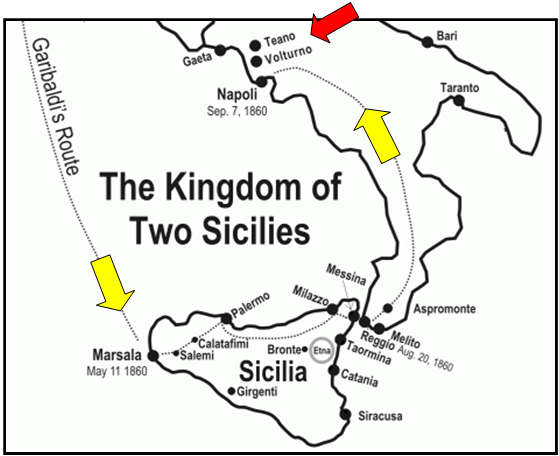
xxxxxIt was there that, learning of a rebellion in Palermo in April 1860, he conceived the idea of mounting an invasion of Sicily in order to bring down the Bourbon kingdom of the Two Sicilies. On the night of May 6th this “hero of two worlds”, as he was then known, assembled an ill-equipped, volunteer army of some one thousand Red Shirts (the distinctive “uniform” of his followers) and embarked for the port of Marsala on the west coast of Sicily. Once there he again showed his remarkable skill as a guerrilla fighter, a man of the people, and a charismatic leader. Although heavily outnumbered by the Bourbon army, he defeated a force at the Battle of Calatafimi, and then, marching across the island, won the Battle of Palermo, and occupied the city with the assistance of a great popular uprising. A further victory at the Battle of Milazzo confirmed his command of the island.
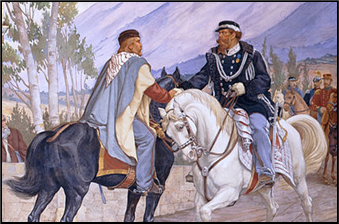
xxxxxThen, true to form and acting in the name of Victor Emmanuel, the King of Sardinia-Piedmont, he went on to invade the mainland and conquer the whole of southern Italy, entering Naples in triumph in early September after a whirlwind campaign. Thexfollowing month he finally defeated the royalist forces at the Battle of Volturno River - aided by the timely arrival of the Piedmontese army from the north - and then, at a meeting at Teano, near Naples (illustrated and arrowed red on map), personally handed over to Victor Emmanuel his conquest of southern Italy - thereby sacrificing republican hopes in favour of Italian unity under a monarchy. A plebiscite held in November brought the whole of the region into the new kingdom. Few military exploits have achieved so much in so short a time and against such overwhelming odds. And no man did more to influence the course of Italian history at this crucial time.
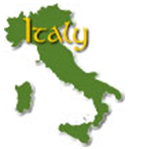
xxxxxDetermined to finish the work of unification, in 1862 he made an attempt to liberate Rome from papal rule - his famous “March on Rome” -, but this was actively suppressed by Victor Emmanuel, who not only feared that this might bring about French intervention, but was also concerned that this much loved national hero might even become a threat to his own rule. Andxa further attempt to occupy Rome, carried out by Garibaldi four years later, was crushed by papal and French forces at the Battle of Mentana early in November 1867. In fact, Rome was to remain outside the new kingdom until France withdrew its garrison from the Papal States in 1870.
xxxxxDespitexhis untimely designs on Rome, in 1866 Garibaldi was given a command in the Tyrol during Italy’s support of Prussia during its Seven Weeks’ War with Austria (1866 Vb). It was from there that he defeated the Austrians at the Battle of Bezzecca. Then in 1870, along with his two sons, he fought for the French during the Franco-Prussian War that broke out that year. After this, however, his fighting days were at last over. He retired to the island of Caprera, just off the coast of Sardinia, and he died there in 1882. More than anyone else, Garibaldi, by his fervent patriotism and outstanding leadership, set in motion the task of achieving Italian unification.
xxxxxIncidentally, Garibaldi received a rapturous reception when he paid a brief visit to England in 1864, and such was his international reputation that in July 1861 Abraham Lincoln offered him a command in the American Civil War. ……
xxxxx…… We are told that as he lay dying he asked that his bed be moved outside so that he could gaze upon “the emerald and sapphire sea” for the last time. His house, reconstructed, is now a museum dedicated to his extraordinary life as a soldier and patriotic leader.
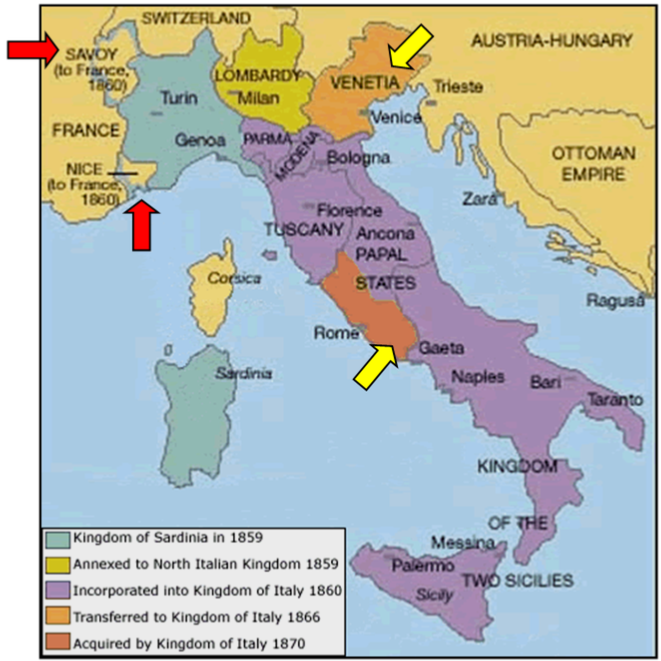
xxxxxIncidentally, Garibaldi’s daring campaign against the Bourbon kingdom of the Two Sicilies - known as the campaign of the thousand - has gone down in the annals of military history as a brilliant example of a popular war in which good leadership and a worthy cause - independence in this instance - were able to triumph over a better-equipped and much larger enemy force. ……
xxxxx…… The success of Sardinia-Piedmont in its fight for Italian unity and independence was assisted in some measure by the attitude of other European states. Great Britain, for example, wanted the establishment of a strong Italian state to counter French influence in the region, and the West European powers were in favour of any action that would help to cut Austria down in size. ……
xxxxx…… Napoleon’s assistance to Sardinia-Piedmont came at a price. In 1860 France was given the regions of Savoy and Nice (arrowed in red), and they have remained as part of France ever since. Nice was Garibaldi’s place of birth, and he strongly objected to it being placed under French rule.






 xxxxxToxrectify this situation, in April 1860 an uprising inspired by Mazzini broke out in the city of Palermo. Known as the Gancia Revolt, it aimed at overthrowing the Bourbon monarch Francis II, whose kingdom, the Two Sicilies, incorporated the island of Sicily and much of southern Italy (including the city of Naples). This was followed in May by an impromptu invasion of the island of Sicily by the Italian patriot Giuseppe Garibaldi (illustrated below). Acting entirely on his own initiative, he set sail from Genoa at the head of a small, ill-
xxxxxToxrectify this situation, in April 1860 an uprising inspired by Mazzini broke out in the city of Palermo. Known as the Gancia Revolt, it aimed at overthrowing the Bourbon monarch Francis II, whose kingdom, the Two Sicilies, incorporated the island of Sicily and much of southern Italy (including the city of Naples). This was followed in May by an impromptu invasion of the island of Sicily by the Italian patriot Giuseppe Garibaldi (illustrated below). Acting entirely on his own initiative, he set sail from Genoa at the head of a small, ill- defeating a Bourbon contingent at Calatafimi, he was joined by a growing number of Sicilians. Aided by their support, the poor showing of his enemy, and his own skill and daring, he captured Palermo on June 6th and, two weeks later, won the Battle of Milazzo, thereby gaining control over all but a small part of the island.
defeating a Bourbon contingent at Calatafimi, he was joined by a growing number of Sicilians. Aided by their support, the poor showing of his enemy, and his own skill and daring, he captured Palermo on June 6th and, two weeks later, won the Battle of Milazzo, thereby gaining control over all but a small part of the island. 

 xxxxxThe Italian national hero and guerrilla fighter Giuseppe Garibaldi (1807-
xxxxxThe Italian national hero and guerrilla fighter Giuseppe Garibaldi (1807-





